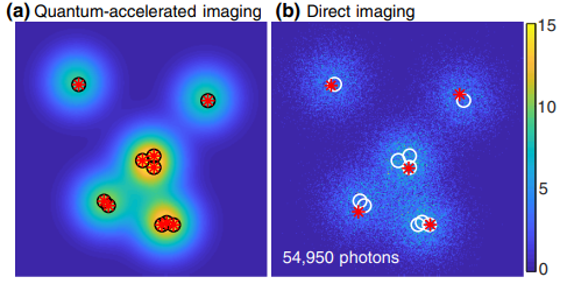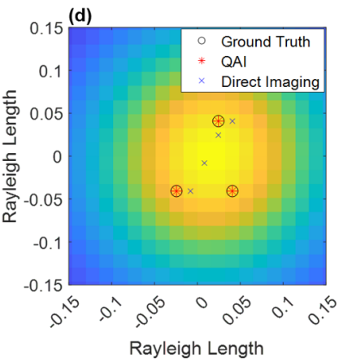Adaptive Quantum-Accelerated Imaging
Quantum Accelerated Imaging
Imaging point sources with low angular separation near or below the Rayleigh criterion is important in astronomy, e.g., in the search for habitable exoplanets near stars. However, the measurement time required to resolve stars in the sub-Rayleigh region via traditional direct imaging is usually prohibitive. We propose quantum-accelerated imaging (QAI) to significantly reduce the measurement time using an information-theoretic approach. QAI achieves quantum acceleration by adaptively learning optimal measurements from data to maximize Fisher information per detected photon. Our approach can be implemented experimentally by linear-projection instruments followed by a single-photon detector array. We estimate the position, brightness and the number of unknown stars 10 ∼ 100 times faster than direct imaging with the same aperture. QAI is scalable to large number of incoherent point sources and can find widespread applicability beyond astronomy to high-speed imaging, fluorescence microscopy and efficient optical read-out of qubits.

Figure: source detection using QAI vs. Direct imaging with photon-starved regime
Source: Bao, Fanglin, et al. "Quantum-accelerated imaging of N stars." Optics Letters 46.13 (2021): 3045-3048.
Moreover, we extend this method to the field of Space Domain Awareness (SDA). The growth in space activity has increased the need for SDA to ensure safe space operations. Imaging and detecting space targets is, however, challenging due to their dim appearance, small angular size/separation, dense distribution, and atmospheric turbulence. These challenges render space targets in ground-based imaging observations as point-like objects in the sub-Rayleigh regime, with extreme brightness contrast but a low photon budget. Here, we propose to use the recently developed quantum-accelerated imaging (QAI) for the SDA challenge. We mainly focus on three SDA challenges (1) minimal a priori assumptions (2) many-object problem (3) extreme brightness ratio. We also present results on source estimation and localization in the presence of atmospheric turbulence. QAI shows significantly improved estimation in position, brightness, and number of targets for all SDA challenges. In particular, we demonstrate up to 2.5 times better performance in source detection than highly optimized direct imaging in extreme scenarios like stars with a 1000 times brightness ratio. With over 10,000 simulations, we verify the increased resolution of our approach compared to conventional state-of-the-art direct imaging paving the way towards quantum optics approaches for SDA.

Figure: Localization of closely located point sources with extreme brightness ratio
Source: Choi, Hyunsoo, and Zubin Jacob. "Adaptive quantum accelerated imaging for space domain awareness." arXiv preprint arXiv:2402.08047 (2024).

